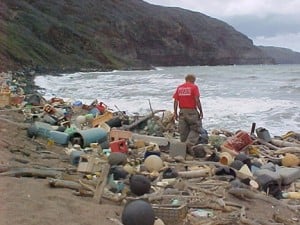Number 22 in the Clean Air Technologies Series.

Trash. By any other name – “garbage,” “refuse,” “rubbish” – trash is, well “trash,” and it is seemingly everywhere. Under the kitchen sink, in the bathroom, on the side of the house or back yard, on the street or out along the highway. Trash – it is the stuff of documentaries, no?!
In fact, there is a new documentary fittingly called: “Trashed,” and in it, no doubt, one will find plenty of trash talk. And who should know better than the main “Trashed” onscreen personality – Oscar-winning actor Jeremy Irons.
Veteran reporter Tracy Smith interviewed Irons on CBS Sunday Morning recently. In that interview it was brought to bear that 90 percent of the world’s refuse could be recycled. Having to do with that, if I understand correctly what was conveyed, just a third of the nine-tenths deemed recyclable actually gets recycled.
Plain and simple: ignoring garbage won’t make the matter disappear.
So, what is the answer?
Part of the answer is in getting consumers to be more recycle-minded or recycle-oriented. Public service announcement campaigns could help in that regard. Another part is finding viable ways to dispose of a lot of it without having to put such in landfills.
Putting discards to good use
At SF.Streetsblog.org, posted is an excerpt (Chapter 1) from architect and author Peter Calthorpe’s book: “Urbanism in the Age of Climate Change.” (Reference: “Urbanism in the Age of Climate Change: Green Technology”). In his message, Calthorpe talks “combined heat and power” or “CHP” cogeneration. He writes:
“Such small-scale power plants can be coupled with district heating and cooling systems to capture and use the generator’s waste heat in local buildings and industry.”
But that’s only the half of it. The other half is cogeneration system fuel supply – biomass, or waste, in other words.
“These plants can burn almost any form of renewable biomass, eliminating the energy-intensive process of converting valuable crops into biofuels or finding mechanisms to transform grass to gas,” Calthorpe insists. “More interesting are a new generation of ‘waste to energy’ technologies that not only produce green electricity and heat but also avoid the massive landfills and trucking costs of typical garbage systems.”
And what we throw away, think about how much could be fodder for biomass incineration.
So, check it out. Emphasizes Calthorpe:
“Currently, for every watt of energy delivered to a home, two thirds is lost as waste heat up the smokestack and in transmission lines. Local cogeneration plants coupled with district heating and cooling systems can largely eliminate these inefficiencies. The waste heat is captured and reused, while the transmission losses are greatly reduced. Because of this, it is estimated that cogeneration systems operate at around 90 percent efficiencies whereas standard power plants average only 40 percent.”
Stated differently, with efficiencies approaching 90 percent there is a roughly 10 percent loss. Compare this with losses of 60 percent. The difference is significant. All made possible by “trash.”
“Co”-generation: like having one’s cake and eating it too.
Image above: U.S. National Oceanic and Atmospheric Administration
– Alan Kandel